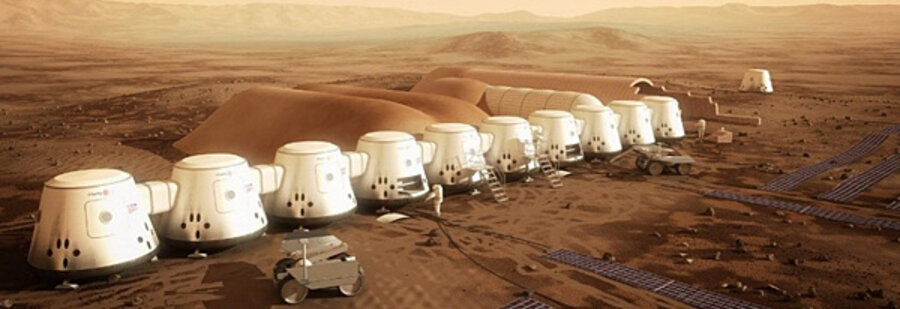Mars One: Who would sign up for one-way trip to Mars? This guy.
Loading...
Like many young men, George Hatcher was in awe of the stars, but there was one twinkle in the night sky that stood out to him: Mars.
Since he was 11, Mr. Hatcher has made it his life goal to step foot on the Red Planet.
Hatcher says he has done everything he could to make himself as appealing as possible to the astronaut selection committee. He is currently in the middle of getting a PhD in planetary science at the University of Central Florida and has worked 10 years as an avionics engineer at NASA’s Kennedy Space Center.
“Exploration and discovery are some of the most exciting things about our existence,” Hatcher says. Going to Mars "would be the opportunity for me to participate in the first grand exploration of the universe."
That goal has become such a part of Hatcher's life that before he and his wife got married he told her that he was going to Mars if he ever got the chance.
"She said OK, as long as we had children first," Hatcher says.
To most people, such a concern might seem silly, but for Hatcher, going to Mars could be a real possibility. Hatcher is one of 705 people who could be chosen to create the first human colony on Mars through Mars One, a nonprofit foundation that is planning to put a permanent human colony on Mars by 2025.
Mars One is the brainchild of Bas Lansdorp, a Dutch engineer and entrepreneur. In 2011, he and Arno Wielders announced that they wanted to have a colony on Mars within 15 years, a short time frame considering its been more than 40 years since a human last stepped foot on the moon.
Last year, Mars One opened the Astronaut Selection Program, and 200,000 people applied to be a part of the program. Hatcher made the first selection, which cut the applicants to 1,000, and is now waiting to hear if he will be one of the 24 people chosen to go to Mars. If selected, Hatcher will begin preparing next year. Every member will train for several months each year at a site in the Arctic desert to learn to operate machinery and improve their ability to deal with prolonged periods of time in a remote location.
Then, in 2024, the first crew of four will make the seven-month journey to the Red Planet. Mars One said the crew will most likely make the trip on a SpaceX Dragon spacecraft, which will be turned into the living quarters upon landing. The crew will work to construct life-support units, growing food, and create the foundation of the first extraterrestrial human colony. Then, beginning in 2026, another crew of four will be sent from Earth to Mars every two years.
Though there is a lot of excitement around the Mars One mission, a recent study by the Massachusetts Institute of Technology found major technical concerns with the goal of creating a colony on Mars by 2025. The study found that it might be possible to get colonists to the planet, but keeping them alive will be difficult.
According to the MIT study, the Mars One crew will have trouble surviving for longer than three months, let alone for the two years before reinforcements arrive.
Under current conditions, crew members would most likely die from dangerously high levels of oxygen. The crew would need to vent oxygen and increase nitrogen levels to keep enough air pressure for them to breathe. While similar technology has been used on Earth, no such system has been tested in space. Even if a system is created to keep oxygen at a safe level, the study says that the cost of growing extraterrestrial food is so great that it is actually cheaper to ship food from Earth than to grow it on Mars.
“The reason is because there is a large upfront cost to build the infrastructure to grow the food,” says Sydney Do, an MIT doctoral student in aeronautics and astronautics and the study’s lead author. “The system to produce food has failure and you need to build spare parts for that.”
If the technology is created before the 2024 launch date, there is no way to ensure that the crew will have the spare parts needed to fix the system should something go wrong. While 3-D printing could be a possible solution, the technology hasn’t been tested in space. So the mission would have to send all of the spare parts from Earth, and given the immense cost and limited launch window, that isn't a reliable possibility.
“The main problem [with Mars One's plan] is that they say no new technology will be used,” says Andrew Owens, one of the study’s authors. He says the purpose of the study wasn't to discount the possibility of a Mars mission. The MIT researchers just want to ensure that the mission is as safe as possible for those involved. “We will learn to solve these problems, and we will be able to develop the technology needed to live on Mars," Mr. Owens says.
During a speech at the Centennial Symposium at MIT, Elon Musk, founder of SpaceX, said he believes humans can create a colony on Mars, but questions whether Mars One's deadline is possible. He challenged Mars One's plan to use his company's current generation of the Dragon spacecraft. The vessel is too small, he says, and the technology to ensure a safe journey isn’t perfected.
“I’ve seen them [talking about] using Dragon spacecraft,” Mr. Musk says, “and I think going to Mars in [the spacecraft] is a bad idea. I think they are going to have to wait for a different generation," which is years away.
Hatcher is fully aware of the dangers and possible problems of the mission. He knows that once he is in the spacecraft, there is no turning back. He will be leaving his family and friends behind and heading for an unknown future. But Hatcher says he won't be deterred from making the journey, because he is excited for the scientific knowledge such a mission could unveil.
"No one knows when they will die or under what situation," says Hatcher. "I would rather die pursuing a goal I have worked towards my entire life and advancing humanity's ability to survive long term away from the Earth than just to live the rest of my life living comfortably."








